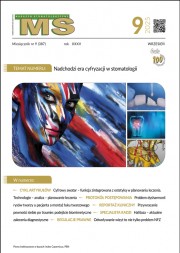Dostęp do tego artykułu jest płatny.
Zapraszamy do zakupu!
Po dokonaniu zakupu artykuł w postaci pliku PDF prześlemy bezpośrednio pod twój adres e-mail.
REPORTAŻ KLINICZNY
Nadwrażliwość pozabiegowa po wykonaniu wypełnienia kompozytowego. Opis przypadku
Post-operative sensitivity in a direct composite restoration. Case report
Aleksandra Łyżwińska
Streszczenie
Nadwrażliwość pozabiegowa może mieć złożoną etiologię. Objawy zgłaszane przez pacjenta bywają niejednoznaczne i często mogą być mylone z zapaleniem miazgi, prowadząc do przedwczesnej decyzji o leczeniu endodontycznym. W opisanym przypadku pokazano proces diagnostyki nadwrażliwości pozabiegowej i jej leczenia poprzez wymianę wypełnienia kompozytowego.
Abstract
The etiology of a post-operative sensitivity could be complex. Sometimes patients complaints are ambiguous and could be mistaken as a pulpitis, leading to premature endodontic treatment. This case report showed a diagnostic process of post-operative sensitivity and treatment in the form of replacement of resin direct restoration.
Hasła indeksowe: nadwrażliwość pozabiegowa, ból na nagryzanie, diagnostyka, wypełnienie kompozytowe
Key words: post-operative sensitivity, pain for biting, diagnostics, direct resin restoration
PIŚMIENNICTWO
- Berkowitz G, Spielman H, Matthews A i wsp. Postoperative hypersensitivity and its relationship to preparation variables in Class I resin-based composite restorations: findings from the practitioners engaged in applied research and learning (PEARL) Network. Part 1. Compend Contin Educ Dent. 2013 Mar; 34(3):e44-52.
- Kaczmarek U. Nadwrażliwość zębiny. W: Jańczuk Z, Kaczmarek U, Lipski M (red.). Stomatologia zachowawcza z endodoncją. Warszawa: Wydawnictwo Lekarskie PZWL; 2014, s. 131-4.
- Närhi M, Jyväsjärvi E, Virtanen A i wsp. Role of intradental A- and C-type nerve fibres in dental pain mechanisms. Proc Finn Dent Soc. 1992; 88 Suppl 1:507-16.
- Hirata K, Nakashima M, Sekine I i wsp. Dentinal fluid movement associated with loading of restorations. J Dent Res. 1991; 70(6):975-8.
- Brannstrom M. The hydrodynamic theory of dentinal pain: sensation in preparations, caries, and the dentinal crack syndrome. J Endod. 1986; 12(10):453-7.
- Chan KHS, Mai Y, Kim H i wsp. Review: Resin Composite Filling. Materials. 2010; 3(2):1228-43.
- Miyazaki M, Onose H, Moore BK. Effect of operator variability on dentin bond strength of two-step bonding systems. Am J Dent. 2000; 13(2):101-4.
- Sabbagh J, Fahd JC, McConnell RJ. Post-operative sensitivity and posterior composite resin restorations: a review. Dental Update. 2018; 45(3): 207-13.
- Canadian Advisory Board on Dentin Hypersensitivity. Consensus-based recommendations for the diagnosis and management of dentin hypersensitivity. J Can Dent Assoc. 2003; 69(4):221-6.
- Opdam NJ, Feilzer AJ, Roeters JJ i wsp. Class I occlusal composite resin restorations: in vivo post-operative sensitivity, wall adaptation, and microleakage. Am J Dent. 1998; 11(5):229-34.
- Lynch CD, McConnell RJ. The cracked tooth syndrome. J Can Dent Assoc. 2002; 68(8):470-5.
- Brunsvold MA, Lane JJ. The prevalence of overhanging dental restorations and their relationship to periodontal disease. J Clin Periodontol. 1990; 17(2):67-72.
- International Classification of Orofacial Pain, 1st edition (ICOP). Cephalalgia. 2020; 40(2):129-221.
- Pigg M, Nixdorf DR, Law AS i wsp. New International Classification of Orofacial Pain: What Is in It For Endodontists? J Endod. 2021; 47(3):345-357.
- Brandt PD, de Wet FA. Posterior composite restorations and post-operative sensitivity. SADJ. 2006; 61(2):064, 066-8.
- Van Landuyt KL, Cardoso MV, De Munck J i wsp. Optimization of the concentration of photoinitiator in a onestep self-etch adhesive. Dent Mater. 2009; 25(8): 982-8.
- Perdigão J, Geraldeli S, Hodges JS. Total-etch versus self-etch adhesive: effect on postoperative sensitivity. J Am Dent Assoc. 2003; 134(12):1621-9.
- Perdigão J, Lopes M. Dentin bonding--state of the art 1999. Compend Contin Educ Dent. 1999; 20(12):1151-8, 1160-2; quiz 1164.
- Garcia R, Giannini M, Takagaki T i wsp. Effect of dentin desensitizers on resin cement bond strengths. RSBO. 2016; 12(1):14.
- Cuevas-Suárez CE, da Rosa WLO, Lund RG i wsp. Bonding Performance of Universal Adhesives: An Updated Systematic Review and Meta-Analysis. J Adhes Dent. 2019; 21(1):7-26.
- Rosa WL, Piva E, Silva AF. Bond strength of universal adhesives: A systematic review and meta-analysis. J Dent. 2015; 43(7):765-76.
- Balkenhol M, Huang J, Wöstmann B i wsp. Influence of solvent type in experimental dentin primer on the marginal adaptation of Class V restorations. J Dent. 2007; 35(11):836-44.
- Kameyama A, Haruyama A, Abo H i wsp. Influence of solvent evaporation on ultimate tensile strength of contemporary dental adhesives. Appl Adhes Sci. 2019; 7, 4.
- Briso AL, Mestrener SR, Delício G i wsp. Clinical assessment of postoperative sensitivity in posterior composite restorations. Oper Dent. 2007; 32(5):421-6.
- Baroudi K, Rodrigues JC. Flowable Resin Composites: A Systematic Review and Clinical Considerations. J Clin Diagn Res. 2015; 9(6):ZE18-24.
- Cho K, Rajan G, Farrar P i wsp. Dental resin composites: A review on materials to product realizations. Composites Part B: Engineering. 2022; 230.
- Chuang SF, Jin YT, Liu JK i wsp. Influence of flowable composite lining thickness on Class II composite restorations. Oper Dent. 2004; 29(3):301-8.
- Nikolaenko SA, Lohbauer U, Roggendorf M i wsp. Influence of c-factor and layering technique on microtensile bond strength to dentin. Dent Mater. 2004; 20(6):579-85.
- Zecin-Deren A, Sokolowski J, Szczesio-Wlodarczyk A i wsp. Multi-Layer Application of Self-Etch and Universal Adhesives and the Effect on Dentin Bond Strength. Molecules. 2019; 24(2):345.














